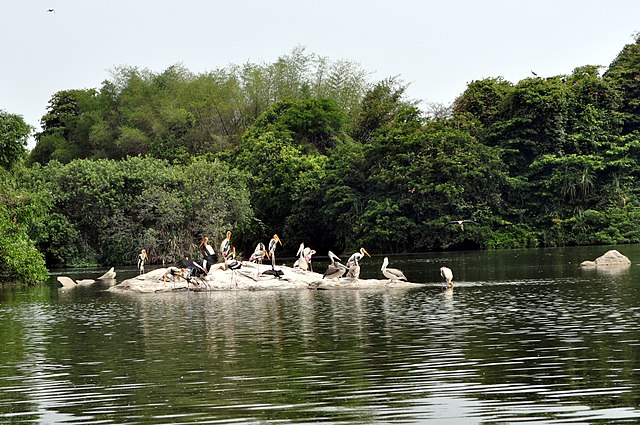Ranganathittu Bird Sanctuary, nestled in the serene landscape of Karnataka, India, stands as a testament to the harmonious coexistence of diverse avian species and nature’s intrinsic beauty. Established decades ago, this sanctuary boasts an array of captivating features that make it a cherished haven for birds and a delightful destination for avid nature enthusiasts.
History and Establishment

The sanctuary’s roots trace back to the 17th century when it was formed on the banks of the Kaveri River. Initially established as a nesting ground to protect birds from predators, it gradually evolved into a designated sanctuary in the 20th century, under the keen guidance of conservationists.
Biodiversity and Avian Species
Various Bird Species Found
Ranganathittu is home to over 170 avian species, including the vibrant Painted Stork, the majestic Asian Openbill, and the elegant Black-crowned Night Heron. Each species contributes to the sanctuary’s rich tapestry of biodiversity.
Migratory Patterns and Seasons
Throughout the year, migratory birds flock to this sanctuary, finding solace in its tranquil surroundings. The winter months witness a flurry of activity as migratory birds seek refuge, making it an ideal time for birdwatchers to observe their behaviors and interactions.
Ecological Importance
Role in Conservation Efforts
The sanctuary plays a pivotal role in conservation efforts, providing a safe haven for endangered species and contributing significantly to avian research and preservation programs.
Impact on the Ecosystem
Its existence reverberates beyond its borders, influencing the ecological balance of the region and contributing to the overall health of the surrounding ecosystem.
Visitor Experience and Activities
Visitors are treated to a myriad of activities, from leisurely boat rides along the river, offering enchanting views of nesting birds, to immersive experiences at interpretive centers, providing insights into avian life.
Conservation Challenges and Efforts
Threats to the Sanctuary
Despite its significance, the sanctuary faces challenges such as habitat degradation and human interference, posing threats to the avian population.
Conservation Initiatives
However, concerted efforts by conservationists and local authorities are underway to mitigate these challenges through habitat restoration and community engagement programs.
Importance for Birdwatching Enthusiasts
For birdwatching enthusiasts, Ranganathittu is a paradise offering unparalleled opportunities to observe and appreciate the intricate behaviors and habitats of various avian species.
Unique Features and Landmarks
Islands and Flora
The sanctuary’s charm is amplified by its picturesque islands adorned with diverse flora, providing nesting sites and sanctuary for birds.
Noteworthy Sightings
Notable sightings of rare species, such as the Spoonbill and River Tern, add an element of exclusivity to the sanctuary’s allure.
Management and Future Prospects
Efficient management strategies ensure the sanctuary’s sustainable growth and continued role in avian conservation, promising a bright future for both birds and visitors alike.
Impacts on Local Communities
The sanctuary’s presence positively impacts local communities through eco-tourism, employment opportunities, and fostering environmental awareness among residents.
Conclusion
Ranganathittu Bird Sanctuary stands as a sanctuary of serenity and biodiversity. Its significance extends far beyond being a mere habitat for birds. It symbolizes the delicate balance between conservation efforts and the enchanting beauty of nature.
The sanctuary’s role in preserving avian species, nurturing local ecosystems, and captivating the hearts of visitors reflects its profound importance. It serves as a testament to the harmonious coexistence between humans and wildlife.
As visitors explore its tranquil landscapes and witness the diverse avian life, they not only indulge in nature’s wonders but also contribute to the sanctuary’s conservation. Together, through appreciation and responsible tourism, we can ensure that Ranganathittu remains a haven for generations to come.
FAQs
Where is Ranganathittu Bird Sanctuary located?
Ranganathittu Bird Sanctuary is situated near Srirangapatna in the Mandya district of the state of Karnataka, India. It’s about 19 kilometers from the city of Mysore.
What makes Ranganathittu special?
This sanctuary is a haven for migratory birds, offering a serene environment surrounded by the Cauvery River. It’s home to numerous avian species, making it a paradise for birdwatchers and nature enthusiasts.
What kinds of birds can be spotted at Ranganathittu?
You can witness a diverse range of bird species including painted storks, spoonbills, egrets, herons, kingfishers, and even migratory birds like pelicans. The sanctuary hosts around 170 species of birds.
When is the best time to visit?
The peak season for birdwatching is from November to June when migratory birds arrive. However, the sanctuary is open throughout the year.
Are there any boating facilities available?
Yes, visitors can enjoy boat rides along the Cauvery River, offering a close-up view of the birds and their habitats. Boating is a popular activity here.
Are there any accommodations available nearby?
While there aren’t accommodations within the sanctuary, there are various hotels and resorts in Mysore and Srirangapatna which offer comfortable stays.
Is there an entry fee to visit Ranganathittu Bird Sanctuary?
Yes, there is an entry fee for both Indian and foreign tourists. The rates may vary, and there might be separate charges for cameras.
Can photography be done at the sanctuary?
Yes, photography is allowed. However, there might be specific regulations regarding the use of drones or professional equipment.
Is it suitable for children and families?
Absolutely! Ranganathittu is a great place for families and children to experience nature up close and learn about different bird species.
How much time is typically spent exploring the sanctuary?
Visitors usually spend around 2-3 hours exploring the sanctuary and enjoying the boat rides. However, enthusiasts can spend more time birdwatching or taking photographs.
Is it easily accessible?
Yes, the sanctuary is easily accessible by road from Mysore and other nearby towns. It’s a popular day trip destination from Mysore.


